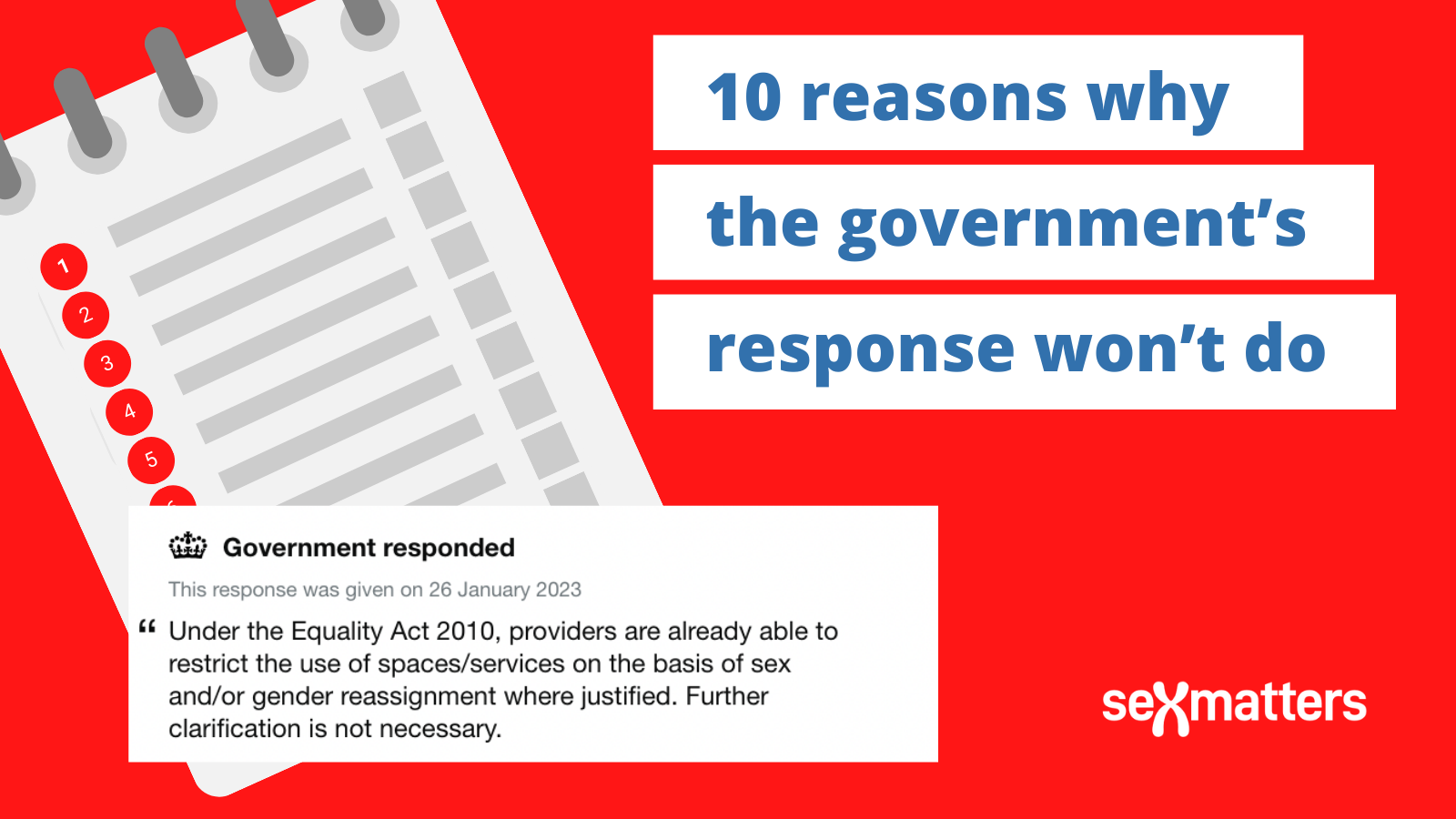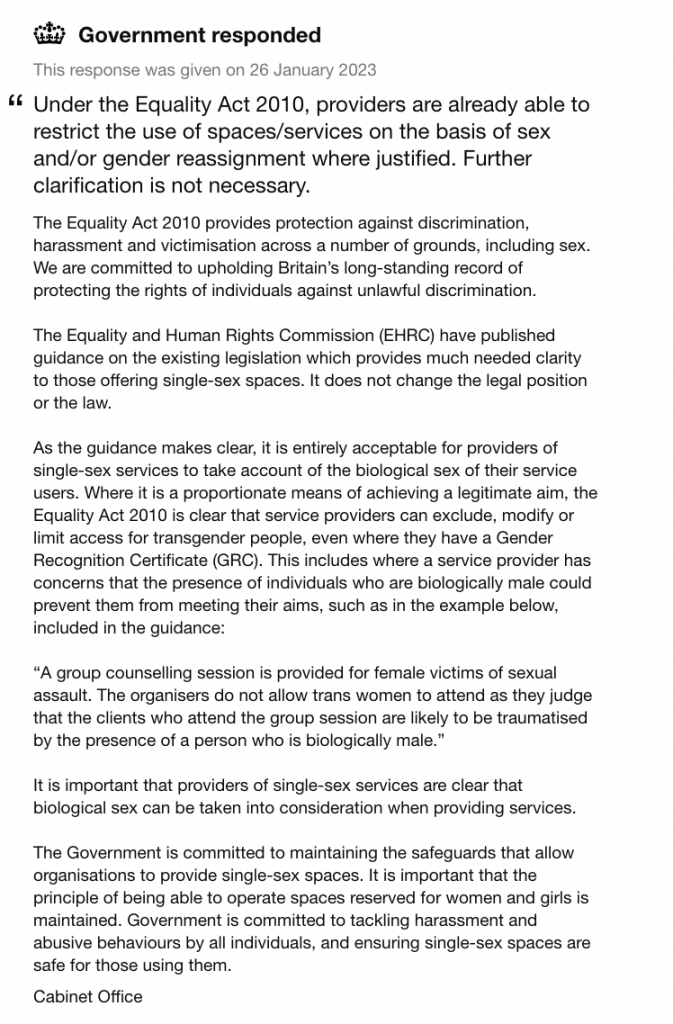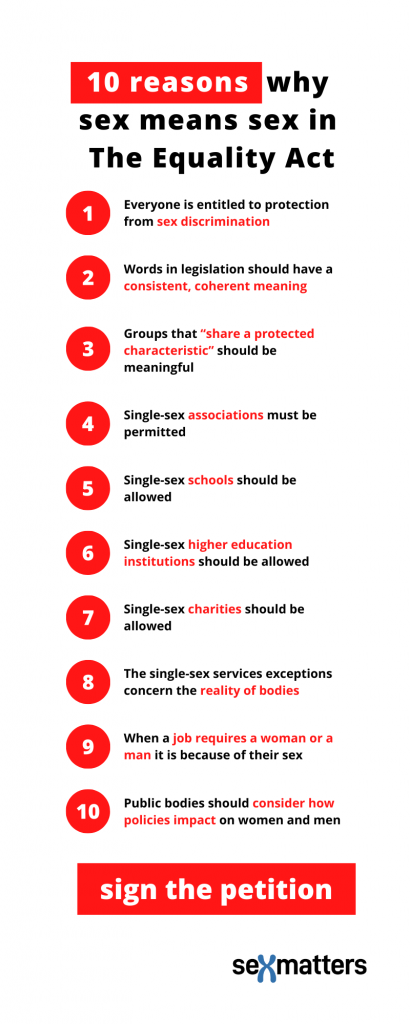Sex in the Equality Act

The government has provided an initial response to our petition. It is over six weeks late and answers a different question from the one that we are asking. Its response focuses on single-sex services.
Under the Equality Act 2010, providers are already able to restrict the use of spaces/services on the basis of sex and/or gender reassignment where justified. Further clarification is not necessary.
Read the government’s full response

Our petition does not specifically mention the operation of single-sex spaces or services but concerns the broader question of the definition of sex in the Equality Act.
The government has stated separately – in the reasons for its Section 35 order to stop the Scottish Gender Recognition Reform Bill – that the impacts of the GRA on the Equality Act go beyond single-sex services.
The government has said that it thinks that a gender-recognition certificate has the effect of changing a person’s sex for the purposes of the Equality Act. This relies on the judgment by Lady Haldane in the For Women Scotland (2) case. We think there are powerful reasons why this ought to be overturned on appeal. This blog post sets out ten reasons.
Our petition calls on the government to enact a simple amendment to the Equality Act, using powers provided for in the Gender Recognition Act. This amendment would clarify the Equality Act and protect everyone’s rights.
We are not asking the government to change the law, but to make it clear.
The next stage is to get to 100,000 signatures so that we can have a debate in parliament.

Ten reasons why sex means sex in the Equality Act
1. Everyone is entitled to protection from sex discrimination
If a GRC changes a person’s sex for the purposes of the Equality Act, those who hold a GRC will lose certain specific protections from sex discrimination in their actual sex. A person who identifies as a “transman” may get pregnant and breastfeed, or be discriminated against because their employer thinks they will. They should not lose protection against sex discrimination for being female just because they have a certificate.
Was it really the intention of the Gender Recognition Act to deprive people with GRCs of that kind of protection? We don’t think so. The much simpler interpretation is that the Gender Recognition Act 2004 does not affect a person’s sex for the purposes of the Equality Act, and therefore does not remove this kind of sex-specific protection.
Are people protected from discrimination in their “new” sex? Yes: to the extent that someone is perceived as being a particular sex (whether they have a certificate or not), or covered by rules that treat them as that sex they can already bring a claim under the Equality Act.
2. Words in legislation should have a consistent, coherent meaning
The use of the words man and woman, male and female and sex in many contexts in the Act can only relate to their ordinary biological meaning – including explicit references to women in relation to pregnancy and breastfeeding, sex in sexual orientation, average athletic performance of the two sexes, restriction of certain combat roles in the armed forces to men, and existing legislative protections for women.
3. The concept of groups that “share a protected characteristic” should refer to meaningful categories
For each of the protected characteristics, the Act defines what is meant by persons who share that characteristic. So for age, that means people of the same age group; for disability, it means people who share the same disability; for gender reassignment, it means transsexual people; for race, it means people of the same racial group; and so on.
In each case, the expression defines a group of people who have something important and material in common.
For sex, “a reference to persons who share a protected characteristic is a reference to persons of the same sex”. That defines a natural and meaningful category if (but only if) sex means biological sex. The groups “biological women plus biological men who hold a certain certificate, minus biological women who hold a certificate” and “biological men plus biological women who hold a certain certificate, minus biological men who hold a certificate” are incoherent groups about whose members it is impossible to generalise meaningfully. “Men” and “women” are distinct natural categories in the same sense that “cats” and “dogs” are. The category of sex if modified by a GRC is like “cats plus dachshunds, but excluding Siamese cats” and “dogs plus Siamese cats, but excluding dachshunds”.
This can be seen most clearly in the context of indirect discrimination, which is the application of a policy or rule which puts people who share a protected characteristic at a particular disadvantage compared to people who don’t share it. The concept of indirect discrimination assumes that meaningful generalisations can be made about groups defined by protected characteristics. That assumption is undermined in the case of sex, if “sex” is given Lady Haldane’s interpretation.
4. Single-sex associations must be permitted
Equality Act 2010, Schedule 16, European Convention on Human Rights, Article 11
Everyone has the right to freedom of association. The Equality Act therefore allows for associations to restrict membership “to persons who share a protected characteristic” without unlawfully discriminating. This is clearly intended to include allowing male-only and female-only associations, associations for gay men, lesbians, women of particular faiths and female sports associations, for example.
The Secretary of State’s reasons for his Section 35 Order assert that the GRA explicitly removed protection for freedom of association in 2004:
“Where an individual has changed their sex for the purposes of the 2010 Act by obtaining a full GRC, the association is therefore not able to refuse membership on the grounds of their previous sex. They also cannot restrict membership to people who are not covered by the gender reassignment characteristic because an association’s membership can only be based on a shared protected characteristic and not the absence of it.”
Alister Jack is right that the gender reassignment protected characteristic only works in one direction: it is not a protected characteristic not to be a transsexual. It follows that if Lady Haldane’s judgment in FWS2 is correct, single-sex associations were outlawed in 2004. That interpretation would not be consistent with the European Convention on Human Rights, and should be rejected for that reason.
5. Single-sex schools should be allowed
Equality Act 2010, Schedule 11
Schedule 11 of The Equality Act provides a simple exception to allow for single-sex schools. If the definition of sex in the Equality Act is said to include a person of the opposite sex who has a gender-recognition certificate, it would be impossible to refuse to admit an 18-year-old with a certificate to a single-sex school for the opposite sex. If gender-recognition certificates are given to 16-year-olds in Scotland, the same would go for a 16- or 17-year-old.
6. Single-sex further and higher education institutions should be allowed
Equality Act 2010, Schedule 12
Schedule 12 of the Equality Act provides a simple exception for sex discrimination in admissions to single-sex institutions of further and higher education (but not for gender-reassignment discrimination). Single-sex colleges are free to admit members of the opposite sex on an exceptional basis. Again, freedom of association requires that women’s colleges are not obliged to include trans-identifying males, even with a certificate.
7. Single-sex charities should be allowed
Equality Act 2010, Section 193
The Equality Act provides for charities that offer benefits to people who share a protected characteristic. There have long been charities that focus on women or men as biological sexes. We don’t think these were outlawed in 2004.
8. The justifications for single-sex services in the Equality Act concern the reality of bodies
The justifications for providing single-sex or separate-sex services (as set out in Part 7 of Schedule 3 to the Equality Act) include where a service is only needed by one sex (for example a cervical-smear-test clinic). There is no service for which the need is dictated by either having a female body or having a certificate declaring you to be a woman. Another justification is where “the service is provided for, or is likely to be used by, two or more persons at the same time, and the circumstances are such that a person of one sex might reasonably object to the presence of a person of the opposite sex”. A woman who reasonably objects to the presence of a man can just as reasonably object to the presence of a man who thinks he is a woman, whether he has a government certificate or not.
9. When a job requires a woman or a man it is because of their sex not their government certificate
Employers are allowed to set requirements for recruiting people who have a particular protected characteristic, including sex, where it is a proportionate means of achieving a legitimate aim. This recognises that there is a material difference between men and women (for example in relation to intimate and personal contact with members of the opposite sex).
10. Public authorities should consider the impact of policies on women and men
Equality Act 2010, Section 149
Public authorities have a duty to work to eliminate discrimination, harassment and victimisation; advance equality of opportunity between persons who share a relevant protected characteristic and persons who do not; and foster good relations between persons who share a relevant protected characteristic and persons who do not share it.
The Reasons for the Section 35 Order state that as a consequence of the GRA:
“when considering the need to advance equality of opportunity between persons who share a relevant protected characteristic and persons who do not share it, decision makers will not always be considering the impact on biological women as a distinct disadvantaged group compared to the impact on biological men, as the protected characteristic of sex is not confined to biological women.”
While we think it is true that many decision-makers make this mistake, we do not think it is true that the legislators decided that the Equality Act should not include biological sex as protected characteristic.
As Yvette Cooper MP – who was in government at the time the Equality Act was passed – argued recently, it is clear-cut and should be straightforward that the law provides protection based on biological sex:
“The Equality Act already provides for recognising that there is a difference between gender, however that is legally recognised and also biological sex, and provides for there to be safe spaces for biological women… This has been something that has long had those arrangements in place, in the law, and it is right that there should be so. It is possible to have a framework that both supports people who are vulnerable who are trans and also makes sure there are protections for women.”
Our proposed amendment
Our amendment makes protection against sex discrimination clear-cut and straightforward. It would not remove rights from people who identify as transgender (who are covered by the separate protected characteristic of gender reassignment whether they have a GRC or not).
The amendment would read:
| (X) In this Act, references to female persons and women: (a) also refer to a person who was born female and has acquired the male sex under the GRA 2004 (b) do not refer to a person who was born male and has acquired the female sex under that Act. (X) In this Act, references to male persons and men: (a) also refer to a person who was born male and has acquired the female sex under the GRA 2004 (b) do not refer to a person who was born female and has acquired the male sex under that Act. |
It would confirm that when the Gender Recognition Act was brought in it did not intend to negate or undermine:
- protection for all women and men against sex discrimination
- legislation on equal pay, based on sex
- protection for freedom of association to have single-sex associations, schools and institutes of higher education
- the ability to have female-only sports
- the ability to have clear single-sex facilities
- the ability to employ people based on sex, where this is a genuine occupational requirement
- the obligation on public authorities to consider impacts of policies on women (female people) as a distinct group.
The Section 35 order refers to the impacts of the GRA on the Equality Act as an “existing problem”. We think it is more than this. The Haldane interpretation, which has been supported by the Government, makes the combination of the GRA and the Equality Act incompatible with the European Convention on Human Rights.
It is the role of the legislature to clarify this.
